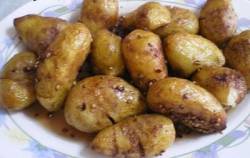Whatever time of year you visit Cyprus there is bound to be some seasonal or religious festival taking place. Synonymous with these special events there are, of course, traditional celebration foods. Check with the calendar below to see what specialties may be on offer and where to find them.
New Year’s Day . Known as St.Basil’s Day in Cyprus, this is a day for optimism, when Cypriots hope for a fruitful forthcoming year. A special cake – Vasilopitta – is baked by each family, and, when it is cut, the person who finds a coin in his slice is promised luck for the forthcoming year.
Epiphany (6th January). A holiday, when all Cypriots go to church to ask for a fruitful and prosperous year to come. Families gather and share a feast of mixed dishes. Loukoumades is the popular sweet of the day. At this time of year the citrus fruit is harvested and lorries loaded with oranges, tangerines, lemons and grapefruit make their way to the ports. In preparation for Lent, Cypriots really let their hair down during the two weeks of carnival prior to the fast. Limassol is famous for its Carnival celebrations and processions, although other towns and villages celebrate too. Look out for seasonal specialities such as pastry bourekia filled with mint flavour cheese and ravioli. Also sticky sweetmeats such as daktyla and kandaifi. The last week of carnival is Tyrini or cheese week and it ends on Green Monday, which is the first day of Lent. Cypriots pack a picnic on this day and head for the countryside. They eat vegetables, olives, bread and salad and they drink village wine.
Lent . Still taken seriously by many Cypriots, no meat, fish or dairy products will be consumed during this period. Pulses, vegetables and fruit, though, are allowed and now that the winter rains have brought the vegetation to life again, just watch the Cypriots gather armfuls of edible greens front the countryside – molohes, pangali and radikia. In the markets you can find strouthoudia, a sort of weed that tastes quite delicious when lightly stir fried in oil and bound together with a little egg. Try some the pastries or Pittes too, kolokopitta made from red pumpkin, raisins and cracked wheat, tahinopitta, made with sesame seed paste, even Spanakopitta combination of spinach and egg wrapped in filo pastry.
Easter. The major religious celebration of the year in Cyprus, when all members of the family join in together to celebrate.Avgolemono soup, made from eggs and lemons in chicken stock, is traditional Easter fare as are the flaounes or savoury Easter cakes which are baked in every household. These contain a special Easter cheese, eggs, spices and herbs all wrapped in a yeast pastry. The main meal for Easter is souvla when the fast is really broken and chunks of mouthwatering meat are roasted on a spit in the spring sunshine.
Summer . Seed blossoms on the trees, and the industrious Cypriot housewives are making orange blossom and rose water to cleanse their faces and to flavour their pastries as well as their fruit preserves known as glyko. Summer is the best time for fruit. Just watch the shops as they fill their shelves with an ongoing supply of strawberries, cherries, apricots, plums, greengages, peaches, grapes, figs, apples, pears and an enormous variety of melons.
Weddings . Popular in the summer, the whole village will turn out to celebrate the happy event. Ressi, a rich pilaf of lamb and wheat is prepared and special little shortbreads (Loukoumia) are piled high for the guests.
September . Begins with the wine festival in Limassol (Lemesos). For over a week in the Municipal Park, Cyprus wine producers will give you the chance to sample all Cypriot wines as well as demonstrations of wine presses, stills and traditional harvest dances. There is, of course, a fine selection of food to eat.
Harvest Time . The busiest time for rural Cyprus. Almonds, carobs, table and wine grapes as well as olives need to be gathered, stored, packed and delivered; but after all this hard work there will be time to celebrate and the Cypriots really know how to do this well! Look out for a village grape festival when palouzes, a blancmange of grape juice, and soutzoukos, a chewy sweet made by dipping strings of almonds into the palouzes, juice, are prepared from the unfermented grapes. After the carob harvest there will be the pastelli, and carob honey which is made from boiled carob pods and is eaten on slices of fresh bread.
Christmas. The time of the Advent fast before Christmas. In the past every family would slaughter a pig and the fresh meat was salted, cured or smoked to last through the winter. Nowadays, many families still make and smoke their own loukanika sausages for Christmas. A Cypriot Christmas cake is the basic British recipe which has been adapted to suit local suppliers – and jolly good it is too! But traditional Christmas baking only really get underway just a few days before December 25th when powdery icing sugar covered kourambiedes or shortbread biscuits are baked as well as melomakarona, spicy buns drenched in honey syrup, and of course koulouria, traditional sesame bread.


